| friedchicken365 |
KATNISS
VS
VIN
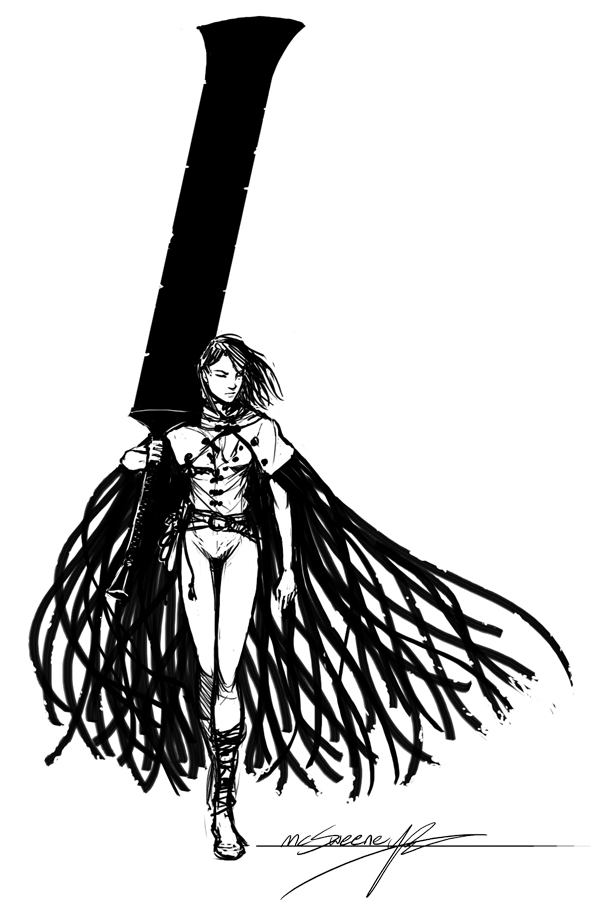 |
| Inkthinker |
Hello All! I finishedthe Hunger Games Trilogy by Suzanne Collins last year, and (with most of the rest of the country) went to see the film based on the first book in theaters. And we are all eagerly anticipating the second film, which hopefully will be a little less shaky cam. But (unlike the rest of the country) I won't be talking about the movie, I'd like to discuss the treatment of heroines in two different trilogies: The Hunger Games, and The Mistborn Trilogy by Brandon Sanderson. The more I thought about this idea, the more it seemed like some sort of English assignment, but I really thought it might be fun to compare and contrast. The heroines both have a great number of things in common, but are very different women. Also, these books are in two different genres and reading levels, so this is kind of an apples and oranges comparison.
ALERT! ALERT! THERE WILL BE SPOILERS!! It is impossible to discuss completely that which you refuse to disclose, so if you don't want to have the stories spoiled, you might not want to read on. But, I'll be posting lots of fan art, so scroll down and take a look :)
For starters, I'll give an overview of both stories.
The Hunger Games (most of you know this but I'll discuss briefly) is a dystopian young-adult fiction that follows a teenage girl, Katniss Everdeen, living under an oppressive regime. She is forced to fight to the death on national television for the entertainment of said regime, becomes an unwitting symbol of rebellion against the regime, helps lead the fight against it, all the while searching for identity and defining for herself what is right and wrong, and deciding whether she loves the boy she grew up hunting with, or the one she was thrown together with in the spotlight.
Book I: The Hunger Games, 374 pages. Book II: Catching Fire, 391 pages. Book III: Mockingjay, 390 pages.
Book I: The Hunger Games, 374 pages. Book II: Catching Fire, 391 pages. Book III: Mockingjay, 390 pages.
Mistborn is a fantasy trilogy which also follows a teenage girl, Vin, living under an oppressive regime. She finds that she has allomantic powers (can use metals to push and pull herself, metal objects, and emotions, i.e. Mistborn) and out of necessity joins a crew that is bent on overthrowing the oppressive regime, which is ruled by a god, and stealing the great wealth they hold, an allomatic metal named Atium. They barely manage to do it, but when the god dies, he warns that they have doomed themselves, and furthermore the Atium is nowhere to be found. Our heroine finds herself unwittingly as a symbol of the rebellion and a reluctant leader. She is torn between a boy who understands her nocturnal Mistborn ways and a man who trusts her completely but could never sympathize with the power she holds, only wield her as a weapon. All the while, the unrest following the rebellion comes to a head as war lords vie for power. Worse yet, as the god predicted, the fabric of existence appears to be unraveling at the seams. A power calls to Vin, seeming to promise to right the wrong beginning to show in the world. She releases it to heal the world, but finds she has made a grave mistake. It ravages the land, and the only remaining hope is to get to the hidden Atium first, before the force can claim it and completely annihilate the world.
Book I: The Final Empire, 541 pages. Book II: The Well of Ascension, 590 pages. Book III: Hero of Ages, 572 pages. There is also a novella (The Alloy of Law), but it takes place generations after Vin's time.
Book I: The Final Empire, 541 pages. Book II: The Well of Ascension, 590 pages. Book III: Hero of Ages, 572 pages. There is also a novella (The Alloy of Law), but it takes place generations after Vin's time.
Already perhaps you see some similarities between our heroines? Let's start with what they have in common.
1. Both our heroines come from self-sufficient backgrounds:
- Katniss, from the age of 12, has had to hunt, beg, and dumpster dive to provide for herself, her mother, and sister
- Vin, the daughter of a prostitute, was orphaned with her abusive older brother, and learned the ways of the underworld out of necessity of survival, working in various thieving crews
2. Both our heroines are a bit unwilling to enter into their own story:
- Katniss understandably is loathe to enter the Hunger Games, as it means almost certain death
- Vin is removed from a violent thieving crew chief by Kelsier, who becomes her mentor, and so is made a part of his crew, almost without any say on her part
3. Both our heroines are mentored by unbalanced, enigmatic characters:
- Haymich, a former victor, is a drunk whose most useful piece of advice to Katniss is "Stay Alive."
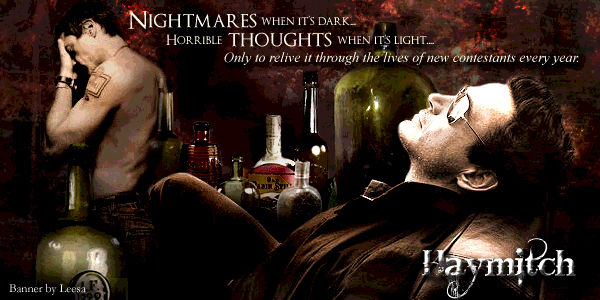 |
| Leesa-M |
- Kelsier, a crew cheif of past renown, has returned from enslavement to lead a rebellion/heist
 |
| mking2008 |
4. Both our lovely heroines find themselves the apex of love triangles:
- As said above, Katniss is torn between her friend and hunting partner, Gale, who is fueled by his hatred for the oppression of the Capitol, and Peeta, who had never spoken to her before they were thrown together in the Games. However, he not only cares not only for her, but for the lives of all of Panem. It takes the entire series for Katniss to pick Peeta for that caring nature, but in all fairness she did have a few other things on her mind.
 |
| ichan-desu |
- Also as said above, Vin is in love with Elend, the impromptu leader of the city after the fall of the Lord Ruler, their former god, for his charm and desire to do good for his people. But he doesn't understand her Mistborn nature the way that Zane, a shadowy assassin and fellow Mistborn does. This triangle only features in the second book of the trilogy, and Vin chooses Elend, even if she is his knife, because he loves her enough to let her go. Also Zane is mentally unstable and tries to kill Vin when she tells him she didn't pick him, which probably didn't earn him any brownie points. Notice a similarity in between Zane and Elend in the picture? Dun - dun - DUN! They're half brothers.
 |
| shorelle |
5. Both our heroines are in the business of overthrowing superpowers:
- As a symbol of the rebellion, Katniss is in on the fight to overthrow President Snow. When she realizes she's trading one regime for another, she takes it upon herself to kill his would-be rebel successor, President Coin.
- The object of the heist in the first book is to overthrow the Lord Ruler, which throws all of the Final Empire into chaos when Ruin (capitolized because he's a being) can take a larger hold on the land and the populace. Several warlords descend on Vin and Elend's city and have to be called to heel (by Vin, of course). When Vin is tricked into freeing Ruin, his touch on the Final Empire is more than tangible and the end of the world is within sight. Through a mind-blowing sequence of events, Vin sacrifices herself to stop Ruin.
6. Both heroines would kick your butt:
- Katniss is deadly with a bow and knife from years of hunting, is experienced at stalking silently through the woods, keeping out of sight, keeping upwind, making snares, not to mention her resourcefulness.... basically you want her on your team.
- Vin did her growing up in alleys and on streets, is quick with a knife, doesn't trust anyone, and can hold her own when it comes to thieving and disguise. When she finds out she's a Mistborn, she takes to it almost as easy as breathing, rendering herself able to leap buildings, throw metal objects, rattle the emotions of others, wield incredible strength, and move faster than humanly possible, not to mention anticipate her opponents actions when she's burning Atium. Subsequently, she's described as a whirlwind several places in the book. An appropriate description in my opinion.
7. Both the heroines are forced into a bit of pretense and dress-up to get what they are after:
- Traditionally the Tributes are dressed up and paraded around before the Hunger Games, and on top of that Katniss has to pretend to be in love with Peeta to get sponsors, then keep up the act even after the Games to protect her family. After the rebellion begins, she is asked to keep pretending for the camera to do propoganda spots to gain support for the rebellion.
 |
| Molly Glover |
- For her part of the heist, Vin infiltrates the aristocracy as Lady Valette Renoux, which allows her to spy on the High Lords and Ladies in the capitol city of Luthadel, as well as start what rumors she can to help bring down the High Houses, aiding in the general collapse of the city as a result of the rebellion.
 |
| mking2008 |
8. Both heroines struggle to find a sense of identity:
- Katniss mostly debates with herself about what she wants to do. She would prefer to go back to her perception of a "normal life" (i.e. how she lived before she was reaped for the 74th Games). She doesn't really have a direction for what she wants, she only knows that she isn't the Katniss that the Capitol wants to portray her, nor is she whole-heartedly the Mockingjay as the Rebels would have her be.
 |
| tracytracy2000 |
- Vin has two separate debates about who she is. In the first book of the trilogy, when she is pretending to be Valette, she struggles because she knows she is neither Valette, nor Vin the Theif, but something else now that she knows she is Mistborn. The second book, in which her love triangle features, she sees both of the men in the triangle as symbols of someone she could choose to be. She could be either a lone Mistborn and an assassin with its own agency, or a Mistborn for the newly formed kingdom and a tool for someone else's use.
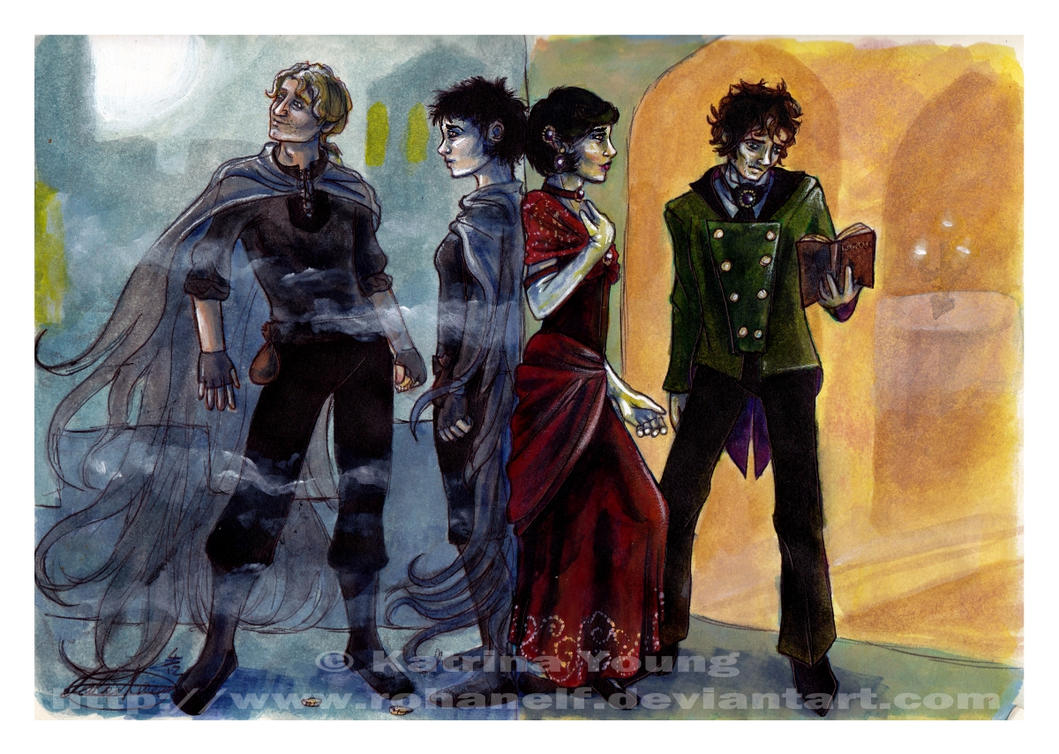
RohanElf
9. Both heroines have mommy issues and absent dads:
- Katniss's father died in a mining accident when she was an adolescent, and her mom withdrew after that. More on PTSD later.
- Vin's father was a government official and her mother was a prostitute. Against protocall, Vin's mother was not killed before she could become pregnant. So, Vin's father was not only absent, but also from the oppressive upper crust Ministry. Vin's mother was mentally unstable and heard voices in her head that told her to kill Vin's younger sister.
10. Both our heroines are in a rigid caste system:
- The Districts are oppressed by the Capitol, which is the upper class and subsides off of the Districts.
- The lower class Skaa's are property of the High Lord's and their families, who in turn vie for power with each other under the Lord Ruler.
11. Both stories have inspired some really incredible fan art (look at these in full size if you can!):
 |
Aleatoire09 lone-momo |
Alrighty. That seems good for now on comparisons. There are more, but I think this is pretty comprehensive. Now for the contrasts! And then I figure I'll end with a little literary criticism of each story individually just for fun.
In keeping with the pattern we'll start with Katniss again and what she has individually special about her.
Now on to the lovely Lady Vin.
 |
| Rat Girl Studios |
- Katniss begins the story knowing her fighting skill. When we meet her, she already knows how to hunt and use a knife and has a small unformed beef with the Capitol, which ends up fueling her "fire" (haha, so punny) in most of her fighting.
- Both of Katniss's love interests are pretty much on the same side in the conflict against the Capitol, but they take different approaches to it. Peeta is a more moderate voice in the conflict that wants to emphasize that a life lost on either side is a tragedy. Gale is ready to make sacrifices and has a bit of a "take no prisoners" attitude.
- Katniss is chosen out as a symbol by the Rebels and takes on her mantle with a few stipulations. She is allowed to participate in the fighting, but really she is still a publicity stunt as opposed to a force that would be missed.
- Katniss tends to keep people at arms length, and when she does open up a tiny crack and let her emotions out, she tends to break down completely. She has difficulty finding a viable balance.
- Katniss loses herself after the Rebels have won and President Snow is dead. She is consumed by her grief and PTSD, even in the epilogue she divulges that she still struggles with nightmares decades after the events.
- There is quite a lot of referral to PTSD. Katniss's mother is our foreshadowing before anything super tragic happens in the story. Katniss and Peeta both have horrible nightmares. Katniss doesn't really have a way to deal with it, but Peeta starts painting after the first games. Haymich is a drunk because of his time in the Games and life afterwards. Many of the former tributes become "Morphlings," or morphine addicts. Annie cracked after her time in the Games and became mentally unstable. Johanna can barely stand water after she was tortured with it by the Capitol.
- A pretty obvious theme is oppressive government vs. oppressed people, corruption, etc.etc.
- A piece of the previous point is the propaganda that goes into both the Capitol's and the Rebel's broadcasting. The Capitol wants to portray Katniss as the innocent lover of Peeta, not a rebel. The rebels want to portray that she was gunning for the Capitol all along and go to great lengths to show her fighting the Capitol. I was cracking up reading the last book because as members of Katniss's team are dying, they're shoving the camera crew forward to keep them alive so that the Rebels can keep rolling footage of Katniss.
- On a related note, the reality-show nature of the propaganda put out by both sides and of the Games themselves resurfaces time and again.
- Katniss is never really convinced that either side is best. The Rebels show a ruthlessness that startles her and ultimately costs her the life of her sister. So I guess this theme is moral uncertainty.
Now on to the lovely Lady Vin.
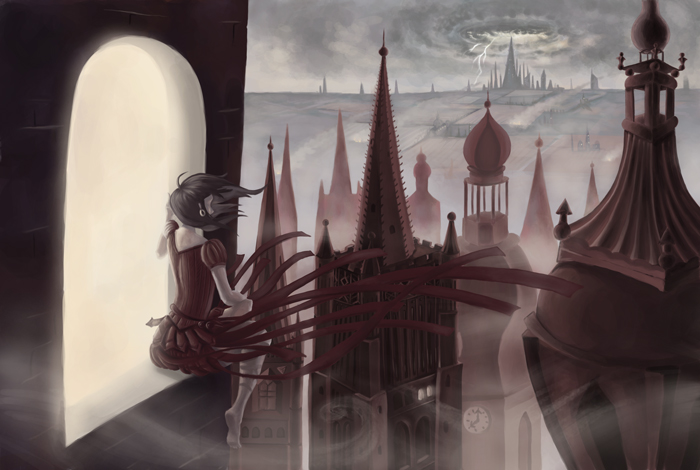 |
| ArchetypeAngel |
- When we meet Vin, she knows only barely how to use her allomancy, most of her life has been spent trying not to be noticed and trying to keep out of the way. Kelsier and his crew teach her how to use her allomancy and how to fight in combat.
- Vin's love interests are on opposing sides of the fight for Luthadel, the capitol city and the stronghold of Elend's reign. Zayne is a Mistborn assasin sent by Straff Venture, the father he and Elend share. However, Elend is High-born from Straff's wife while Zayne's mother was a Skaa mistress. Zayne is sent to Luthadel to eliminate Vin and Elend, but holds back to see if he can convince Vin to run away with him.
- Vin becomes a symbol of the Skaa rebellion because she was trained to be Mistborn by Keliser and (mostly) because she killed the Lord Ruler. She tries to ignore and evade this fawning adoration throughout the second book, and in the third book it really becomes a non-issue because the need to survive overrules the need for democratic order. She still has her fame and the power that comes with it, however, and uses them to try to gain support for Elend to unite the kingdoms.
- When we meet Vin she has trust and abandonment issues from living a life in the Skaa underground. After joining the crew and gaining confidence in her self, she learns to overcome this. She is able to use her emotional connections to lean on when she needs them instead of trying to hold everything in and relying only on herself.
- In the end, Vin loses herself to the spirit of Preservation (Ruin's counterpart) and becomes herself a god in his place. This lets her sacrifice herself and force Ruin out of existence to save the world.
- Many stories have the heroes overthrow the evil power, and then they end. Really, that happens at the end of the first book, and then the characters have to try to put some sort of infrastructure back into place for the rest of the story. This is an interesting discussion, if you will, on what happens when you try and institute democracy in a society that previously was an empire.
- Like The Hunger Games, Mistborn also deals with oppressive government vs. oppressed people and corruption.
- Religion and, as one of the characters puts it, "godhood" play a big role in the Mistborn Trilogy. When the rebels overthrow the Lord Ruler in the first book, he's their oppressive god. His priests act as the bureaucracy, and hunt down those with allomantic powers that aren't pure highborn. When Kelsier dies, few of the general populace believe he is actually dead and start to worship Vin as his prodigy and replacement. In the second book, Vin and her colleagues come to believe that he oppressed a power that could save their world from the natural forces that were trying to tear it apart. It turns out that power was Ruin, so when Vin releases it, she's up against an actual god, not just a man with super-powers styling himself as an emperor. Vin sacrifices her life to become Preservation to defeat Ruin, and when both of those powers are "unposessed," as it were, Vin's companion takes them both on to become a more balanced god, Harmony.
- In the last book, Vin and her cohorts really wrestle with trying to do what you believe is best for a people group without making it seem like everything you do is self-serving.
- Another problem faced time and again is the superstition about the power of the mist, which turns out to be foreshadowing.
- There are a number of creatures in the trilogy that can take on the form of others, and also a number of creatures that are made from men into things that are not. This begs the question of whether or not humane treatment of these creatures should be considered, and also how they see their own identity.
- Another big theme (thank you Andrew Woodard) is moral uncertainty, as in The Hunger Games. In the second and third books, Vin wrestles with whether what she's doing (and has been doing) is actually helping her cause. Also, she finds out that the Lord Ruler enacted his taxing regime in an effort to save their world.
While both stories have compelling characters, plots, and themes, I personally prefer the Mistborn Trilogy to the Hunger Games. This has nothing to do with genre or reading level, it has to do with the decisions that the heroines make in the end, and how they deal with their problems.
Katniss feels that she can't share her stress with anyone. She has been self-reliant for so long that she doesn't know how to do anything but keep her fear and anger and worry bottled up inside. She increasingly falls to panic attacks as her story progresses. Invariably someone will hit her with a sedative and she'll wake up in a hospital bed. And here is the part where I'll step on toes: Katniss is not a hero, she's a martyr. She was chewed up and spit out by the revolution, used by both sides, and what is left afterwards has forgotten how to function in everyday life. She was strong at the beginning of the story, but at the end she's broken. This is not a story to inspire young women to be heroes, although there are inspiring parts. This story is a warning about what happens when we use people indiscriminately as tools. Watching Katniss and her fellow surviving tributes struggle through their PTSD constantly reminded me of the soldiers that have come home after serving and chose to end their own lives rather than face their memories and nightmares.
Vin, it can be argued, is an unrealistic heroine because she has magic in her allomantic powers, so she isn't as helpless. But if you are a human with magic, and you're fighting gods, the odds are as equally stacked against you as if you were a normal human fighting a government. I talked about it a little earlier, but Vin finds constructive ways to deal with her difficulties. She will voice her concerns to her companions. She is also one of the people making decisions, as opposed to a tool. (Yes, Katniss does get some agency in the third book, but it's really too little, too late.) This gives her more control over her destiny and makes her feel more empowered, which helps counter the helplessness that can overcome so easily. Vin is also able to channel her feelings of anger and helplessness into fighting, and Katniss tends to crack when the pressure gets too great. One of the things Vin's mentor Kelsier is fond of saying is, "There's always another secret." This spurs Vin on to keep trying, even when she feels like she's drowning in failures.
So, if you've made it with me to the end, what are your thoughts? Agree? Disagree? If you've read the Hunger Games and haven't picked up the Mistborn series, I'd encourage you to do so. I haven't given away the whole trick, and even if I did, my ramblings can't compare to the actual story.


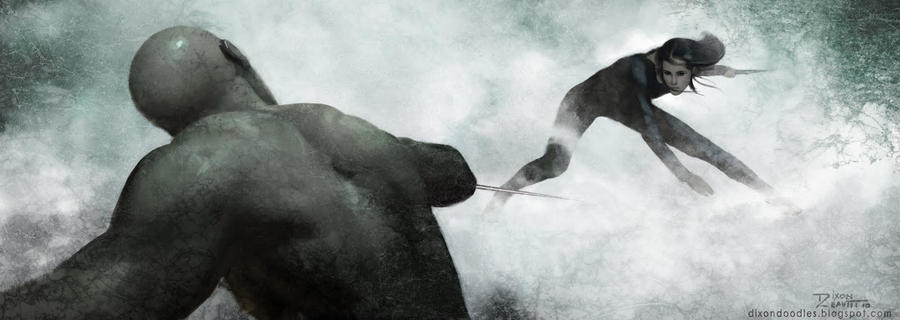
Mindkettőt többször is olvastam! Imádom őket! Jó cikk volt, köszönöm.
ReplyDeleteThis post does a great job of highlighting the real challenges HR students face today, especially when balancing theoretical concepts with practical applications. The discussion around academic pressure and evolving HR frameworks is particularly relevant. In the middle of managing case studies, policy analysis, and tight deadlines, hr assignment help can be a valuable support system for students aiming to maintain quality and accuracy. Overall, this article offers useful insights for anyone pursuing HR studies.
ReplyDelete